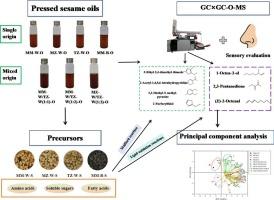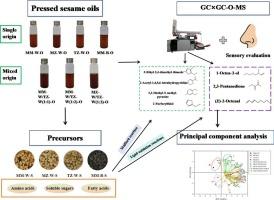解码压榨芝麻油的香气:感官属性,种子来源和香气前体
IF 9.8
1区 农林科学
Q1 CHEMISTRY, APPLIED
引用次数: 0
摘要
压榨芝麻油的香气分布系统地受到种子来源、混合比例和成分前体的影响。本研究表征了七种压榨芝麻油的香气化合物(四种单一来源;三种多来源混合物)。感官评价显示出普遍高强度的脂肪和烤的味道。仪器分析鉴定出93种芳香化合物,主要是含氮和含硫化合物。坦桑尼亚白芝麻油(TZ-W-O)的化合物含量最高;混合油近似于主要的原料来源。驱动香气分化的主要气味剂是5-乙基-2,4-二甲基噻唑、2-乙酰基-1,4,5,6-四氢吡啶和1-辛烯-3-醇。PCA将样品分成四个簇,其中TZ-W-O由于醛类和含氮化合物的增加而形成一个独特的组。在种子氨基酸、可溶性糖和脂肪酸中存在显著的来源差异。相关分析显示吡嗪类与赖氨酸/丝氨酸水平呈正相关,醛生成与油酸呈正相关。研究结果为优化压榨香油风味奠定了基础。本文章由计算机程序翻译,如有差异,请以英文原文为准。


Decoding the aroma of pressed sesame oils: sensory attributes, seed origins and aroma precursors
The aroma profile of pressed sesame oil is systematically influenced by seed origin, blending ratios, and compositional precursors. This study characterized aroma compounds in seven pressed sesame oils (four single-origin; three multi-origin blends). Sensory evaluation revealed universally high intensities of fatty and roasted notes. Instrumental analysis identified 93 aroma compounds, predominantly nitrogen- and sulfur-containing species. Tanzanian white sesame oil (TZ-W-O) contained the highest compound levels; blended oils approximated the dominant raw material origin. Key odorants driving aroma differentiation were 5-ethyl-2,4-dimethylthiazole, 2-acetyl-1,4,5,6-tetrahydropyridine, and 1-octen-3-ol. PCA segregated samples into four clusters, with TZ-W-O forming a unique group due to elevated aldehydes and nitrogenous compounds. Significant origin-based variations occurred in seed amino acids, soluble sugars, and fatty acids. Correlation analysis revealed positive correlations between pyrazines and Lys/Ser levels, while aldehyde formation was positively correlated with oleic acid. These findings establish a foundation for optimizing pressed sesame oil flavor.
求助全文
通过发布文献求助,成功后即可免费获取论文全文。
去求助
来源期刊

Food Chemistry
工程技术-食品科技
CiteScore
16.30
自引率
10.20%
发文量
3130
审稿时长
122 days
期刊介绍:
Food Chemistry publishes original research papers dealing with the advancement of the chemistry and biochemistry of foods or the analytical methods/ approach used. All papers should focus on the novelty of the research carried out.
 求助内容:
求助内容: 应助结果提醒方式:
应助结果提醒方式:


